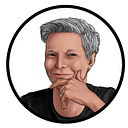Your Feed and Your Friends
This Monday musing was sparked when my friend Laura Mignott gently questioned my assumptions (thank you, Laura!). If you aren’t already listening to Laura on The Reset Podcast, download it now!
What’s in your feed?
Scan your social media feed. (Go ahead. I’ll wait…)
- Does it tell you about a huge tech conference that happened last week? No, I’m not talking about TrailheaDX, I’m talking about the Lesbians Who Tech (Not IRL) Pride Summit.
- Does it tell you about AfroTech, the Disability:IN conference, and working with people of all faiths?
- More importantly, does it tell you about Derek Chauvin’s sentencing, the indigenous children found buried at residential schools, or the colorism of In the Heights? (Because work and life aren’t separate.)
“You are what you eat,” the old saying goes. Today, you are the social media you consume. If you’re only following people with the same identities as you, you’re missing out on ideas and events and news from the perspective of other identities. And as we know, the identity of the person telling the story makes a big difference in how the story is told.
Ack! I’m in an echo chamber!
If you look at your feed and see only people like you, that’s no surprise. (In fact, if you already have a diverse feed, I want to know how that happened!).
In my experience, people are drawn to people who are similar to them. It feels safe, but it’s limiting. Good news: when you step outside of your identity bubble, you’ll realize that, at the core, we’re all the same. Step 0 is noticing you’re in a bubble.
My “Ack!” moment was in 2014 when Leah McGowen-Hare suggested I take a close look at my Twitter feed. Turns out, I was mostly following White women in the Salesforce ecosystem. Straight, cisgender, able-bodied White women whose religion wasn’t an overt part of their identity. She said, “You need to diversify your feed.”
Step 1: Diversify your feed
I began on Twitter by following technology leaders who were also members of the Black community. It was a small and slow change. I followed Leah and a few people she retweeted. Then, when I saw an interesting article or retweet, I followed the people mentioned.
Then, I made a conscious effort to fill in my Diversify Your Feed “bingo card”. I noticed I had no idea what was happening in the Indigenous community, or the Transgender community. So, I followed new people, read articles they posted, and watched movies they recommended.
Following people on social media is a low-risk step. It’s one-sided and you’re an observer. It’s a great way to learn. Do this now, and soon you’ll be ready to get outside your bubble in real life.
Step 2: IRL
Scan your mobile phone text threads. Look around your dinner party table. Glance across the field at your outdoor concert.
Does everyone in your IRL (in real life) social circle reflect your own identities? (Again, if they do, this is not a surprise.)
Changing your social circle is harder, but possible. It takes more time, because friendship takes time, so don’t rush it. Start online, replying to people you’re following, being part of the conversation, getting to know people.
When we return to in-person events, go to the events you’re hearing about in your feed and meet new people. In every social setting, widen your lens by checking in with yourself: “Am I only talking to people who remind me of me? Who can I talk to that has a different identity?”
Warning, don’t be weird about this. If you’re White, do not say “Hi, so, you’re Black and I don’t have any Black friends, will you be my friend?” Trust me. This. Does. Not. Work.
Build authentic relationships by being authentically interested in getting to know that person as a person.
What’s the impact?
When I saw the change it was having in my life, I began preaching to others to diversify their feed. I have it on good authority that this has had a positive impact on at least one person...
How do I know if my feed is diverse?
If you’re like me, you’re following almost 4000 people. How can we tell if our feeds are diverse? I googled “how to figure out the demographics of your feed” and here’s what I found:
It’s not possible to get this data.
I did find tools that analyze who’s following me, but not who I’m following. These tools only show age and gender “based on name, location, and bio.” (Location? Are there certain places that only women live? Like convents? ::starts singing Sound of Music::)
I need a tool that helps me analyze who I’m following and suggest people who aren’t the same as everyone else in my feed (I’m looking at you, Twitter’s “Who To Follow” feature). So, all you entrepreneurs out there, here’s a market opportunity! (And, if these tools are out there and I’ve missed, them, please let me know.)
Will you #DiversifyYourFeed?
As I wrap up this musing, I’m wondering if the corporate diversity tools:
- analyze the social feeds of the company leaders, company managers, and employees as a predictor of how diverse the company could grow to be?
- suggest people for executives to follow to expand their network, leading to a higher chance the candidate pool for executive roles is diverse?
If 80% of hires come from employee referrals, it seems like having everyone diversify their feed is a pretty effective strategy, right?
Right. But for now, let’s start with you and your network — will you #DiversifyYourFeed and challenge folks in your network to do it with you?
